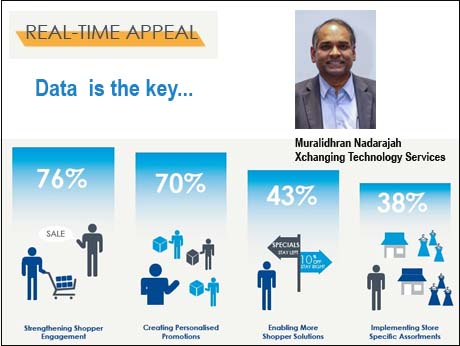
Muralidhran Nadarajah, Head–Analytics Practice, Xchanging Technology Services, explains why data analytics is central to success in the retail trade
Brick-and-mortar stores have traditionally offered the promise of unparalleled customer service. Direct interaction between customers and store employees has been the key to the success of the retail industry globally.
Kishore Biyani, the erstwhile CEO of Future Group, one of India’s most prominent retail chains, is known to have stood in one of his stores making notes on how consumers shopped. This sort of information gives detailed insights into how a customer responds to a product, what interests a customer and how to best position a product. But with consumers’ increasing omni-channel approach to retail, technology is rewriting the way the retail industry functions.
At the core of this technology is data analytics. A decade ago, if a product didn’t sell, the store manager would remove it off the shelves and sell it at discounted rates, possibly taking a financial hit. Today, data analytics has the power to help retailers predict where a product should be positioned in the store and in which particular department. It’s not a subjective analysis, but one driven by intensive data crunching mechanics designed for a mobile generation.
During peak buying seasons these insights into a consumers buying habits can be a game changer for businesses to stay a step ahead of competitors. Retailers, both online and offline, are turning to hiring data crunching engineers to create the best strategy to attract customer attention - from the store or web layout to the product display at the store entrance and on the shelves.
To understand the compass of customer demand, one has to dig deep into shopping behaviour and patterns. This information holds the key to interpreting shopping trends, which can lead to increased operational efficiency, and redirecting sales workforce to areas calling for attention. Additionally, this information is invaluable to refining and improving the customer experience.
Customising the Customer Experience
One of the most powerful enablers of predictive analytic tools is its ability to facilitate mass customisation. As we move into an age where consumers are looking for differentiators, consumers are increasingly demanding bespoke products and services. The traditional approach of one-size-fits-all is outdated in today’s digital age. This impedes the supply chain efficiencies. To work around this, a retailer by leveraging the right analytical tools, can alter the production based on consumer demands.
One way to stay a step ahead of competition is to analyse the social media tools- such as Facebook and Twitter by crawling through the mountain of data this medium generates. This data then needs to be analysed and interpreted to identify buying patterns in consumer preferences. Retailers can then forecast the nature of future demand. At a time when retailers are trying to minimise the average ‘clicks’ it takes before an order is placed online, analytics can provide the right answers.
Predictive sciences can also help in ‘re-targeting’ today’s on-the-move consumers, who gradually are making their purchases from mobile devices With the exponential growth of native advertising, mobile is becoming the big frontier to watch out for. Mobile advertising alone is expected to grow to $41.9 billion by 2017 ( ref 1) , according to research firm Gartner Inc. Without forward looking data sets, a company cannot crack this mighty market.
The new age battle – Online and Offline
Customer analytics is the ability to retain existing customers, with innovation and also attract new customers. Through sentiment analysis, chain store retailers can understand the key motivators of buyer behaviours. By mapping out these behavioural patterns, retailers can woo customers by predicting responses on particular products. This allows companies to introduce targeted marketing campaigns, aimed at specific customers.
Today brands send customised emails of their latest offerings to their customers. With the growth of e-Commerce, a vendor can reach out to their customers with specific and targeted products and services based on their previous shopping preferences.
After acquiring a loyal fan base, analytics can engage customers and build brand advocates by offering special services like priority delivery, early access to the product line, first preferences on newly introduced products, and cheaper discounts among a host of other benefits.
A second is 1000 whole lingering milliseconds
Analytics presents an opportunity to edge out archaic analysis and use data to show tangible returns. With growing disposable incomes and rise in consumer expenditure, retailers need to up their game, and data presents a compelling case.
It’s no secret that e-tailers are devising methods to read a consumer’s mind, data scientists are being hired by the dozen for their insights and special skills. These data analysing teams are tasked not only with improving targeted products for consumers, but how to persuade consumers from brick and mortar stores to online shopping portals.
The retail battle is on, and is being fought with laptop screens beaming figures and servers transmitting data – as it should be in a world that is being defined by technology.
Ref (1) Source: Gartner Says Mobile Advertising Spending Will Reach $18 Billion in 2014, Gartner, 2014